The King's Palace, Palais Royal (Royal Palace), which overlooks the Parc de Bruxelles, was begun in 1820 and had a grandiose face-lift in 1904. The older side wings date from the 18th century and are flanked by two pavilions, one of which sheltered numerous notables during the 1800s. Today the palace is used for state receptions. It also contains the offices of the current King Albert II, though he and Queen Paola do not live there. When the national flag flies, it means the King and Queen are in Belgium.

Place Royale, Brussels' royal square was laid out in 18th-century neoclassical style and graced by an equestrian statue of the leader of the First Crusade, Duke Godefroid de Bouillon. The Bellevue Museum is located here. A former 18th century luxury hotel, it also used to be a royal residence. A fascinating, underground extension of the Bellevue Museum is the Palais du Coudenberg (Coudenberg Palace), more accurately the excavated ground floor and foundations of this sometime palace of the dukes of Burgundy and the Habsburg emperors that burned to the ground in 1731.
The Musée Instrumental (Museum of Musical Instrument) is just steps away from Place Royale. Only 5% of the museum's immense collection is shown at one time so the collection rotates periodically. Palais de Justice (Palace of Justice) is the court complex housed in an extravagant neoclassical building. Dedicated to the might and majesty of the law, it was completed in 1883 after 20 years of construction.
Palais de Justice
Between Place Royale and Palais de Justice are the city's premier collections of both historical and modern art in a single institution, the Musées Royaux des Beaux-Arts (Royal Museums of Fine Arts). These two museums, the Musée d'Art Ancien (Museum of Historical Art) and the Musée d'Art Moderne (Museum of Modern Art) shows off works, most of them Belgian, from the 14th to the 20th centuries. Further down the road is Eglise Notre-Dame du Sablon (Church of Our Lady of the Sablon), a flamboyant late-Gothic church, dating from the 15th to the 16th centuries. The construction was paid for by the city's Guild of Crossbowmen, and was their guild church. Inside is a celebrated statue of St. Hubert, stolen from Brussels and taken to Antwerp but was seized and returned to the church in 1348, where it has remained ever since.

Musée Instrumental & Musées Royaux des Beaux-Arts

Eglise Notre-Dame du Sablon







No comments:
Post a Comment